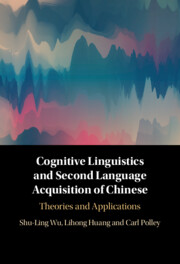Book contents
- Cognitive Linguistics and Second Language Acquisition of Chinese
- Cognitive Linguistics and Second Language Acquisition of Chinese
- Copyright page
- Contents
- Figures
- Tables
- Abbreviations
- Preface
- 1 Cognitive Linguistics and Second Language Acquisition
- 2 Construal in Language
- 3 Concepts and Categorization
- 4 Iconicity and Image Schemas
- 5 Metaphor and Metonymy
- 6 Polysemy
- 7 Embodied Cognition and Mental Simulation
- 8 Teaching Chinese Modal Verbs
- 9 The Future of Cognitive Linguistics in Chinese Studies
- References
- Index
8 - Teaching Chinese Modal Verbs
Published online by Cambridge University Press: 01 February 2024
- Cognitive Linguistics and Second Language Acquisition of Chinese
- Cognitive Linguistics and Second Language Acquisition of Chinese
- Copyright page
- Contents
- Figures
- Tables
- Abbreviations
- Preface
- 1 Cognitive Linguistics and Second Language Acquisition
- 2 Construal in Language
- 3 Concepts and Categorization
- 4 Iconicity and Image Schemas
- 5 Metaphor and Metonymy
- 6 Polysemy
- 7 Embodied Cognition and Mental Simulation
- 8 Teaching Chinese Modal Verbs
- 9 The Future of Cognitive Linguistics in Chinese Studies
- References
- Index
Summary
Chapter 8 presents a new empirical study to illustrate how CL insights can help inform L2 teaching and learning of Chinese modal verbs. It offers a study that compared the effectiveness of a newly designed CL-based instructional method with that of the traditional instruction used in a mainstream Chinese textbook in the United States. The proposed CL-based instruction taps learners’ analytical abilities to see connections between the root and extended meanings of modal verbs as well as the subtle distinctions among them. The chapter suggests sample focus-on-form communicative tasks that simulate real-life scenarios. By following up these tasks with CL-based explicit explanation, teachers of Chinese can ensure long-term retention and automation in L2 acquisition of modal verbs.
Keywords
- Type
- Chapter
- Information
- Cognitive Linguistics and Second Language Acquisition of ChineseTheories and Applications, pp. 178 - 205Publisher: Cambridge University PressPrint publication year: 2024

